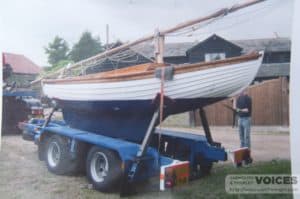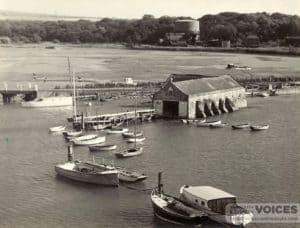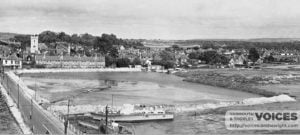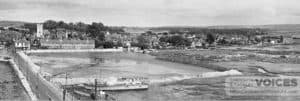Colin and Stan Smith travelled to Canada in WWII to train as RAF pilots. After the war, they returned, and built the ‘Nova Espero’ ,the forerunner for Siani class, in which they crossed the Atlantic,
After WWII
After the war I think I got demobbed first actually, or just a little before my brother.
I went back to Saunders Roe for a while and went up in the mould loft in the drawing office for a little bit, and did things of that sort.
Stan, my brother, and I went out to Canada. We’d done our flying training out there and we didn’t go right inland where we’d done the training, we went over to Nova Scotia where we built the little boat, Nova Espero – Esperanto from New Hope, and sailed it across.
It was intended to be a two way trip. Nobody knew us when we went there so we thought we’d make ourselves known a little bit by doing a double crossing, that was the intention.
She was a half decked boat, twenty foot long. We designed it on the way across on the Aquitania. We’d get down in our cabin and get the lines out and work on it, the lines were all ready by the time we got to the side.
We took only about three months I think altogether, something like that to build the boat in Nova Scotia. We went over in March and left in the beginning of July 1949. I’d been doing design work and all that, drawing work down at Saunders Roe. Stan had as well. We both chipped in on this one. She was quite a tough little boat, clinker built and a hundred weight of cast iron ballast on the keel underneath.
We didn’t know if anyone had done any trips, prepared for it before hand or anything like that, so we adjusted ourselves with what we thought we needed and that was it. Sponsorship, we’d never heard of that. We worked it out and had lockers along the side of the boat under the side decks and tried to figure out what we’d need and got loads and loads of ships biscuits, far more than we needed, I suppose, and lots and lots of tinned stuff and that kind of stuff, powdered milk and lots of sugar. Couldn’t do without that. For water we had twenty eight gallons I think. We had one made up, a galvanised tank with a tap in one corner. We had that stowed up, just after the mast, up forward under the cabin. We had no bunks. We just about had sleeping bags, laid those out on the cabin floor, you see. I’d say we were probably wet most of the time.
It was July through August. We had some pretty nasty weather at times too of course. We had a little portable radio we hoped to get the time checks or weather checks or something like that. Didn’t get a peep out of it from the time we left so we dropped it over the side and that was that. We had a sextant, not an aircraft sextant, a proper little sextant, yacht sextant, and an aircraft compass which wasn’t actually mounted in the boat at all. We used to carry it around with us you know and that was what we used. We were concerned when the weather got really nasty and it did at times too. We had a little primus stove, a little loose primus stove we used to hold between our knees, and a little pressure cooker. We used that a lot. We didn’t do too bad you know.
Afterwards, mostly it was going up to this do up in London, and this do and all that sort of thing, which we just hadn’t expected of course, and all that sort of nonsense. But there was one firm that wanted to turn the boat into production or something, but we didn’t go along with it, we were too busy.
We were going back to Canada and set up in business over there but it didn’t come off. I came back to this country, met my wife and got married and that was that.







